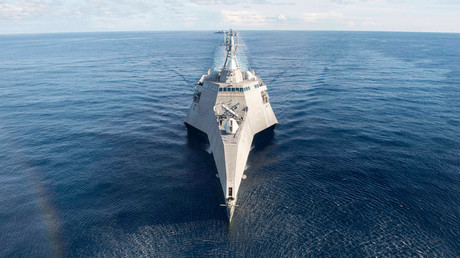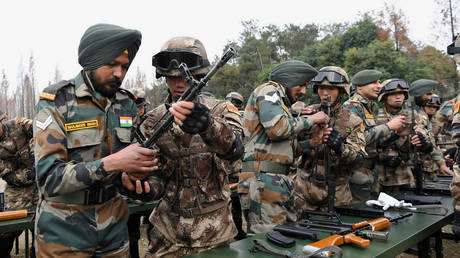Ο Darius Shahtahmasebi είναι νομικός και πολιτικός αναλυτής με έδρα τη Νέα Ζηλανδία και ειδικεύεται σήμερα στο μεταναστευτικό, το προσφυγικό και το ανθρωπιστικό δίκαιο.
Στο πλαίσιο της προετοιμασίας για το δόγμα της Trump's 'America First', η Ιαπωνία εξαπολύει $ 243δις σχέδιο αμυντικής δαπάνης
Ένας στρατιώτης της Ομοσπονδίας Ταχείας Ανάπτυξης της Ιάπωνης Γηπέρας της Αυτοάμυνας (JGSDF) (ARDB) © Reuters / Issei Kato
Η Ιαπωνία αναμένεται να εγκαταλείψει το ειρηνικό της παρελθόν και να ξεκινήσει ένα μακρύ και επικίνδυνο δρόμο για στρατιωτικοποίηση και πιθανή αντιπαράθεση με τους γείτονές της, σύμφωνα με πρόσφατα δημοσιευμένα έγγραφα για τις δαπάνες για την άμυνα.
Μετά το τέλος του Β 'Παγκοσμίου Πολέμου, οι στρατιωτικοί των Ηνωμένων Πολιτειών κατέλαβαν την Ιαπωνία και επέβαλαν στη χώρα ένα μοναδικό σύνταγμα το οποίο, εν όψει του, απομάκρυνε τον πόλεμο για πάντα. Το άρθρο 9 του Συντάγματος δεν επιτρέπει στην Ιαπωνία να διατηρεί στρατιωτική δύναμη και απαγορεύει τη χρήση βίας για τη διευθέτηση διεθνών διαφορών.
Πολύ παρόμοιο με το γεγονός ότι η Ιαπωνία είναι συμβαλλόμενο μέρος σε μια διεθνή σύμβαση η οποία δεν επιτρέπει τη φαλαινοθηρία και εξακολουθεί να συμμετέχει στην απαγορευμένη δραστηριότητα σε παγκόσμιο επίπεδο (και τώρα θα επιταχύνει τις φαλαινοθηρικές δραστηριότητές της), η Ιαπωνία ποτέ δεν τήρησε αρχές του επονομαζόμενου Συντάγματος της Ειρήνης.
Για παράδειγμα, η Ιαπωνία είναι ένας από τους μεγαλύτερους παίκτες στον κόσμο στον τομέα της εθνικής άμυνας με έναν από τους καλύτερους εξοπλισμένους στρατιωτικούς του κόσμου, γνωστούς ως δυνάμεις αυτοάμυνας (SDF), οι οποίοι αποσκοπούν στην ενίσχυση της δύναμης για την υπεράσπιση της Ιαπωνίας σε περίπτωση επίθεσης . Το έθνος επίσης φιλοξενεί τον αμερικανικό στρατό και τις βάσεις του, εξουσιοδοτώντας τις Ηνωμένες Πολιτείες να επιτεθούν σε πολλά ανυπεράσπιστα έθνη. Στην πραγματικότητα, ο πληθυσμός της Οκινάουα, που επιβαρύνθηκε με το καθήκον να φιλοξενήσει αυτές τις στρατιωτικές βάσεις (παρά τα έντονα και ατελείωτα ποσά διαμαρτυρίας) φέρεται να ενοχοποιείται για τη συνενοχή της γης τους στις αμερικανικές εισβολές του Ιράκ και του Αφγανιστάν, καθώς η Οκινάουα διαδραμάτισε αναπόσπαστο ρόλο μέσω της ανάπτυξης στρατευμάτων και ναυτικών σκαφών.
Οι στρατιώτες του Ινδικού Στρατού και του Λαϊκού Απελευθερωτικού Στρατού της Κίνας (PLA) συμμετέχουν σε κοινή στρατιωτική άσκηση στο Chengdu © ReutersΗ διάβολος που γνωρίζετε: Παλιούς εχθρούς Η Ινδία και η Κίνα ενισχύουν τους δεσμούς καθώς η Αμερική αποδεικνύεται υπερβολικά αναξιόπιστη
Τώρα, η Ιαπωνία δεν κάνει κανένα μυστικό για τις προθέσεις της να γίνει παγκόσμια στρατιωτική δύναμη. Την περασμένη Τρίτη, το υπουργικό συμβούλιο του πρωθυπουργού Shinzo Abe ενέκρινε τις μεσοπρόθεσμες κατευθυντήριες γραμμές για την άμυνα και σχετικό αμυντικό σχέδιο, γνωστό ως κατευθυντήριες γραμμές του προγράμματος για την εθνική άμυνα και το μεσοπρόθεσμο σχέδιο άμυνας. Το σχέδιο θα δει την Ιαπωνία να δαπανήσει περίπου 243 δισεκατομμύρια δολάρια για την άμυνα κατά τα επόμενα πέντε οικονομικά έτη, μέχρι το 2024.
Δεν αποτελεί έκπληξη το γεγονός ότι το έγγραφο ασχολείται κατά κύριο λόγο με τον περιφερειακό αντίπαλο της Κίνας, εκφράζοντας παράπονο για την "έντονη ανησυχία" της Ιαπωνίας σχετικά με μια κατάσταση "αβέβαιης περιφερειακής ασφάλειας" που προκάλεσε η στρατιωτική επέκταση της Κίνας. Η Ιαπωνία ανησυχεί επίσης για την αντιληπτή απειλή της Βόρειας Κορέας. Πέρυσι, η Βόρεια Κορέα εξέπληξε δύο βαλλιστικούς πυραύλους πάνω από την Ιαπωνία, μια κάπως προκλητική κίνηση κατά τη διάρκεια του ασταθούς πολέμου Trump-Kim που τελικά κατέληξε σε μια συμβολική μορφή εποικοδομητικού διαλόγου.
Τα μέσα μαζικής ενημέρωσης πιθανότατα δεν θα το θέσουν τόσο ακανόνιστα, αλλά ο στόχος της Βόρειας Κορέας εκείνη την εποχή ήταν πιθανότατα να αποδείξει στις Ηνωμένες Πολιτείες ότι είχε τη δυνατότητα να χτυπήσει τις δυνάμεις της τοποθετημένες στην Ιαπωνία, καθώς και στο Γκουάμ και τη Νότια Κορέα. Ενώ η ιδέα πίσω από τον αμερικανικό στρατό που σταθμεύει στην Ιαπωνία είναι η φερόμενη προστασία της Ιαπωνίας από χώρες όπως η Κίνα και η Βόρεια Κορέα, αναμφισβήτητα θέτει τον ιαπωνικό πληθυσμό σε μεγαλύτερο κίνδυνο δεδομένης της επιθυμίας της Ουάσινγκτον να προκαλέσει και να αντιμετωπίσει έθνη όπως τα προαναφερθέντα.

Για πρώτη φορά μετά τον Β 'Παγκόσμιο Πόλεμο, η Ιαπωνία επιδιώκει να μετατρέψει δύο πλοία σε αεροσκάφη για να αντιμετωπίσει την Κίνα, καθώς και την αγορά πάνω από 100 F-35 ως μέρος αυτού του αμυντικού σχεδίου αξίας 243 δισεκατομμυρίων δολαρίων. Το σχέδιο περιλαμβάνει την επιθυμία να αποκτηθούν δύο αεροπλανοφόροι ικανές να εκτοξεύουν αεριωθούμενα αεροπλάνα.
Ανησυχώντας για το «ναυτικό αποτύπωμα» της Κίνας, ένας Ιάπωνας αξιωματικός της άμυνας δήλωσε στην AFP ότι η Ιαπωνία έχει "πολύ, πολύ μικρό αποτύπωμα SDF" στην περιοχή μεταξύ Okinawa και Ταϊβάν. Οι αερομεταφορείς και τα νέα αεροσκάφη μαχητικών αεροσκαφών θα αυξήσουν την επιχειρησιακή ευελιξία για τον στρατό της Ιαπωνίας, ενώ η Κίνα θα αυξήσει τη ναυτική της αντοχή στα νότια ύδατα που φιλοξενούν αμφισβητούμενες περιοχές μεταξύ των δύο ασιατικών δυνάμεων.
Τον Απρίλιο του τρέχοντος έτους, το Reuters ανέφερε ότι οι δαπάνες στρατιωτικής άμυνας του Πεκίνου ξεπέρασαν κατά πολύ την Ιαπωνία κατά περίπου τρεις φορές. Προφανώς, δεν χρειάστηκε πολύς χρόνος για να πάρει το σημείωμα το Τόκιο και να αποφασίσει ότι ήρθε η ώρα να ενισχύσει τα σχέδια δαπανών του.
Αξίζει να σημειωθεί ότι ο παππούς του πρωθυπουργού Αμπέ ήταν, όπως περιέγραψε ένα κινεζικό μουσείο, ένας «εγκληματίας κατηγορίας Α». Είναι η εικόνα και η κληρονομιά του παππού του ότι ο Αμπέ ασκούσε μια τέτοια αναδιαμόρφωση του ιαπωνικού συντάγματος.
In preparation for Trump’s ‘America First’ Doctrine, Japan unleashes $243bn defense spending plan
Darius Shahtahmasebi is a New Zealand-based legal and political analyst, currently specializing in immigration, refugee and humanitarian law.
Following the end of World War II, the United States military occupied Japan and imposed on the country a unique constitution which on the face of it, renounced war for good. Article 9 of the Constitution disallows Japan from maintaining a military force and outlaws the use of force in settling international disputes.
Much in the same way that Japan is party to an international convention which disallows whaling all the while it stillcontinues to take part in the globally banned activity (and will now reportedly be rapidly accelerating its whaling activities), Japan has never really adhered to the principles of its so-called Peace Constitution.
For example, Japan is one of the world’s largest spenders on national defense with one of the world’s best-equippedmilitaries, known as the Self Defence Forces (SDF), which are intended to empower the force to defend Japan in the instance of an attack. The nation also plays host to the US military and its bases, empowering the United States to attack many defenseless nations. In fact, the population of Okinawa, burdened with the task of hosting these military bases (despite vehement and endless amounts of protesting) reportedly feels guilty for their land’s complicity in the US-led invasions of Iraq and Afghanistan as Okinawa has played an integral role through the deployment of troops and naval craft.
Now, Japan is making no secret about its intentions to become a global military force. Last Tuesday, Prime Minister Shinzo Abe’s Cabinetapproved its midterm defense guidelines and an associated defense plan, known as the National Defence Program Guidelines and the Mid-Term Defence Plan. The plan will see Japan spend approximately $243 billion on defense over the next five fiscal years, until 2024.
Unsurprisingly, the document is mostly concerned with its regional arch-rival China, lamenting Japan’s “strong concern” over an “uncertain regional security” situation caused by China’s military expansion. Japan is also concerned by the perceived threat posed by North Korea. Last year, North Korea famously fired two ballistic missiles over Japan, a somewhat provocative move during the volatile Trump-Kim war of words which eventually resulted in a symbolic form of constructivedialogue.
The media most likely won’t ever put it so bluntly, but North Korea’s aim at the time was most likely to demonstrate to the United States that it had the potential to strike its forces stationed in Japan, as well as Guam and South Korea. While the idea behind the US military being stationed in Japan is to allegedly protect Japan from countries like China and North Korea, it arguably puts the Japanese population at greater risk given Washington’s desire to provoke and confront nations like those aforementioned.
For the first time since World War II, Japan is seeking to convert two ships into aircraft carriers in order to confront China, as well as the purchase of over 100 F-35s as part of this $243 billion defense plan. The plan includes the desire to acquire two aircraft carriers capable of launching fighter jets.
Concerned by China’s “naval footprint”, a Japanese defense official told AFP that Japan has a “very, very small SDF footprint” in the area between Okinawa and Taiwan. The aircraft carriers and new fighter jets will, according to the official, “increase operational flexibility” for Japan’s military while China increases its naval prowess into southern waters that are home to disputed territories between the two Asian powers.
In April of this year, Reuters reported that Beijing’s military defense spending far outpaced that of Japan’s by approximately three times as much. Evidently, it did not take too long for Tokyo to get the memo and decide it was time to boost its spending plans.
It pays to note that Prime Minister Abe’s grandfather was, as one Chinese museum described, a “Class-A-war criminal.” It is in his grandfather’s image and legacy that Abe has pursued such a redrawing of the Japanese constitution.
Abe has long advocated the disposal of the peace clause of Japan’s constitution, which some scholars would use to technically nullify the existence of the SDF even in its traditional form. If he is able to cement the status of the SDF legally, Abe will allegedly be one step closer to establishing for Japan a regular standing army.
Abe has begun efforts to procure a number of offensive weapons, including Tomahawk cruise missiles and F-35s. Under Abe, Japanese troops have also begun training to take part in military expeditions overseas.
In 2016, Japan deployed its first set of troops overseas since the end of World War II, with 350 soldiers venturing into the UN mission in South Sudan. These troops weren’t being stationed there to admire the scenery; they had explicitly been granted the ability to use force to protect civilians, as explained by UN staff. According to the Council on Foreign Relations (CFR), SDF forces have also been deployed to Iraq and Afghanistan.
In April this year, Japan’s SDF also activated its first Marine brigade since World War II in order to counter a potential Chinese invasion of Japan’s claimed territories along the edge of the East China Sea. While ludicrously underreported, this was a heavily controversial move at the time because as Reuters notes, “amphibious units can project military force and could, critics warn, be used to threaten Japan’s neighbors.”
Reuters also explains that the brigade is the latest segment of a growing marine capability that also includes helicopter carriers, amphibious ships, Osprey tilt-rotor troop carriers, and amphibious assault vehicles.
Japan has already begun orders for two long-range Aegis Ashore missile interceptors worth approximately $1.2 billion each to defend its disputed island territories, as well as nine E2D early warning detector aircraft valued at $3.13 billion.
While China and North Korea are the obvious “usual suspects” with regard to Japan’s proposed defense-spending and defense plan, many observers may be surprised to learn that tensions between Japan and another key US ally are quietlyheating up beneath the radar. On December 20, a 3,900-ton class KDX-I destroyer belonging to the South Korean Navy allegedly locked its “separate target illumination radar” on a patrol aircraft belonging to the Japanese Maritime SDF. According to Defense News, directing the fire control radar at a target is regarded as being only one step away from the actual firing toward the intended target. Seoul has denied that the destroyer used the target radar.
As it transpires, South Korea is slowly but surely becoming less and less concerned with the activities of North Korea and is becoming more concerned with its neighboring countries, including and especially Japan.
For a long time, the United States has relied on South Korea and Japan to join Washington in a trilateral defense force that is able to provide a buffer against China in the region. However, much like the rest of the world, including Washington’s traditionally most closest allies, South Korea is heading toward a future in which it would no longer need to rely on the US military for its wartime operations. It would appear from the latest announcement from the Abe government, that Japan is not too much further behind, either.
Abe’s plans for the militarization of Japan are not necessarily welcomed by the Japanese public, with thousands of protesters attending anti-war rallies in Tokyo and other major cities. Even recent polls show that the majority of respondents in Japan oppose Abe’s plans to amend the constitution. That being said, polls also show that the Japanese public does not trust China in the slightest.
In an attempt to quell the public’s concerns, Chief Cabinet Secretary Yoshihide Suga said that the proposal aims to reinforce air defense systems within “the minimum necessary level of force permissible”under Japan’s peace constitution. Japan’s Defence Minister, Takeshi Iwaya, also attempted to win the public onside by explaining that this spending is “indispensable” to protect Japan.
Protecting Japan and protecting the people of Japan are two completely different things. The island of Okinawa has suffered years of abuse under the occupation of the US military and continues to do so to this day. Honourable mentions include the storing of Agent Orange on Okinawa, still present in Okinawa’s ecosystem even today; the deaths of primary school children from fighter jet crashes; noise pollution; rampant crimescommitted by personnel including rape, abduction, murder – to which there is little to no justice – just to name a few.
Perhaps protecting Japan is the wrong terminology to use. The latest developments may entail that Washington and Tokyo end up slowly going their separate ways; and China and Japan may end up on a path to war, all the while Tokyo will have to account for the rise of South Korea’s military prowess in the region.
At the end of the day, American-based defense contractors are the only group of people who are genuinely set to benefit immensely in the immediate short-term future, not the Japanese public, or any other player for that matter.



Δεν υπάρχουν σχόλια:
Δημοσίευση σχολίου